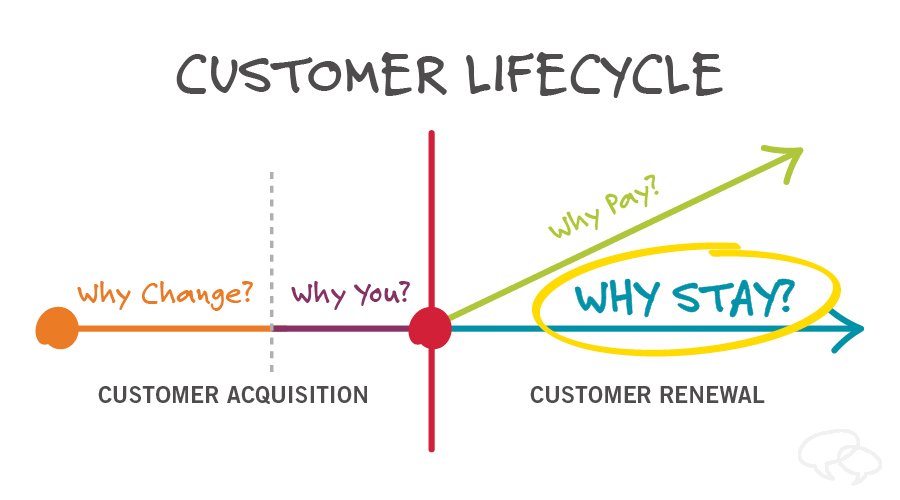
In a sales conversation, a great “Why Change” story is all about disruption. It sets the scene in your prospect’s world, then hammers away on the status quo, casting it as a dark and dangerous place where they can’t achieve their business goals. It’s like the ocean in Jaws. Things might be nice and refreshing at first, but disruption is circling around you, ready to bite at any moment. Then, at the precise right time, the story pivots to a better way, a provocative insight your prospect hasn’t even considered before. With your solution, your customer can be the heroic lifeguard that saves the day.
But in a Why Stay story, a sales renewal strategy where you’re looking to keep an existing customer, the story moves on a different arc. As it should. After all, the purpose of a Why Stay Story is fundamentally different than the Why Change story, as Corporate Visions research confirms.
The key finding from the research is that you need to do two things well to make the biggest impact with your renewal messaging:
- You need to document the specific results of your partnership and share those first before trying to affirm why you were, and continue to be, the right choice for your customer.
- You then need to provide more expanded detail about the recent advances in your solution that are helping your customers keep pace with the market and anything your competition is offering.
When it comes to what kind of message works best in a sales renewal strategy, the results speak for themselves.
Let’s go into a little more detail about the different elements of the best “Why Stay” story.
Act 1: Set the tone with recent successes.
A Why Change story sets the scene solidly in the world of a prospect’s goals and objectives. It presents what it is they want to achieve, both today and in the future. On the other hand, a powerful Why Stay story starts by showcasing the recent successes of working with your company. You might talk about how good things are going today, why they chose you in the first place, and how your relationship tracks well for the future. In other words, you want to validate their original decision to choose you, showing that you’ve helped shore up the key performance challenges you promised you’d improve at the outset.
Act 2: The status quo is your happy place.
Here you want to stabilize the reason why they chose you in the first place. And you do that by reminding them of the great decision they made years ago to go with your company, making you their new status quo. But as anyone knows, the best stories aren’t all about unicorns and rainbows. You need a dark storm brewing. You need conflict. In a story where you’re trying to lock up a renewal, that’s where the risk of change comes in. In this scenario, change is actually the villain. This is the opposite of the Why Change story, where change is the hero. But in a Why Stay story, part of the conflict comes from a competitor lurking around your customers, and from the idea that change is often costly and fraught with risk. Here, your job is to make the status quo the safest place imaginable. It’s your “happily ever after.” Of course, your customers are listening to the competition. A provocative outsider message can make change incredibly alluring. And make no mistake, your competitors are doing everything they can to make it as captivating as possible. But while change is exciting, it can be scary as well, and that’s exactly what you want to convey in your “Why Stay” story: Leave the status quo at your own peril!
Act 3: Mention the “cost of change” as a rising conflict.
At this point in the story, you’ve made your case that working with you has been great in the past, that the status quo (working with you) is a safe and lovely place, and that change can create instability and conflict. Now, you need to dig that conflict in a little further. In a “Why Stay” message, you need to explain how turning to a competitor could lead to a ton of turmoil. Here, you give them real world examples—the cost implications of changing vendors, the operating costs that have already been “sunk” to get your solution performing well, the new investments you’ve made in improving your solutions, the amount of time it takes to onboard all your people and get a new solution running optimally. It’s not just about the hassle of changing vendors, it’s the mountain of costs they’re underestimating or haven’t considered.
Resolution: Detail the competitive advantages of staying with you.
This is the part in the “Why Stay” story where the clouds clear, the sun pops out, uplifting music plays, and the best possible scenario is…to stay the course. At the end of the day, you need to convey that there’s no reason to take on all the unnecessary risks involved with change. You do this by reminding them that you’ve continued to update and tweak your program to keep pace with any other competitive offerings in the market, and that they’re getting the best available solution they can. In this way, you make the status quo as alluring as possible, one that feels valuable and right.
Here’s the great thing about telling a compelling Why Stay story: After yoru sales renewal strategy wins the client over, you can build on your successes, adding chapter after chapter of your adventures together. So by the time the next renewal comes around, you have an epic saga to tell.





